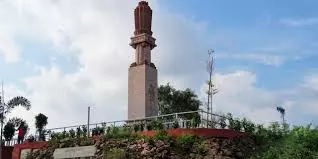Gandhi Hill in Vijayawada a Unique Tribute to Father of the Nation

Gandhi Hill in Vijayawada. (Image: VIjayawada Tourism)
VIJAYAWADA: Vijayawada hosts a hill in the name of Mahatma Gandhi. Gandhi Hill, with its Gandhi Temple, is a unique tribute to the Father of the Nation.
The Mahatma used to visit this city frequently and also conducted AICC meetings at the foot of this hill. This prompted leading freedom fighters to name the hill in his honour.
Gandhi Hill is located behind the Vijayawada Railway Station. Apart from the 52-foot memorial stoopa erected in 1968, Gandhi Hill has a library, a planetarium and a children's train service that offers picturesque views of Vijayawada.
A temple is another major draw. Its walls carry 500 Gandhi Slokas. The temple organises 23 days of Deeksha and worship of the Mahatma idol in Vijayawada. This is the only temple that treats the Mahatma as its deity.
Gandhi’s six visits to Bezawada, now known as Vijayawada, kindled the spirit of freedom among the Telugu population and bolstered the Indian independence movement.
The visits were between 1919 and 1946. His first appearance here was on March 31, 1919, where he spoke on Satyagraha at a public gathering held in the Rammohan Roy Library. The Congress Working Committee met in 1921 at the historic Victoria Museum, where freedom fighter Pingali Venkayya presented the tricolour flag to the Mahatma --a design that was later adopted as the national flag.
Vijayawada stands out as the only location in India with a hill named after the Father of the Nation.
Captain Charles Alexander Orr oversaw the construction of an anicut on the Krishna river in 1852, which was later upgraded to be the Prakasam Barrage. Captain Orr resided on the hill near the Vijayawada railway station, which then came to be known as Orr Hill.
Old-timers reminisced about a public meeting held near Vijayawada railway station, where Gandhi, Mohammad Ali Jinnah, Sarojini Naidu, Jawaharlal Nehru, and other leaders spoke. This culminated in the establishment of the bustling commercial hub known as Gandhinagar here.
Andhra Arts Academy Chairman Golla Narayana Rao, from a family of freedom fighters, recalled how Gandhi stayed at their residence during his visit in 1921. The family preserves the room and almirah Gandhi used. The family served food on gold plates to the leading freedom fighters, but Gandhi preferred to eat from his own silver plate.
Typical of his sense of dedication to the Freedom movement, Gandhi donated the gold plate, offered to him by the family, to the Swarajya Nidhi.
Gandhi Hill is located behind the Vijayawada Railway Station. Apart from the 52-foot memorial stoopa erected in 1968, Gandhi Hill has a library, a planetarium and a children's train service that offers picturesque views of Vijayawada.
A temple is another major draw. Its walls carry 500 Gandhi Slokas. The temple organises 23 days of Deeksha and worship of the Mahatma idol in Vijayawada. This is the only temple that treats the Mahatma as its deity.
Gandhi’s six visits to Bezawada, now known as Vijayawada, kindled the spirit of freedom among the Telugu population and bolstered the Indian independence movement.
The visits were between 1919 and 1946. His first appearance here was on March 31, 1919, where he spoke on Satyagraha at a public gathering held in the Rammohan Roy Library. The Congress Working Committee met in 1921 at the historic Victoria Museum, where freedom fighter Pingali Venkayya presented the tricolour flag to the Mahatma --a design that was later adopted as the national flag.
Vijayawada stands out as the only location in India with a hill named after the Father of the Nation.
Captain Charles Alexander Orr oversaw the construction of an anicut on the Krishna river in 1852, which was later upgraded to be the Prakasam Barrage. Captain Orr resided on the hill near the Vijayawada railway station, which then came to be known as Orr Hill.
Old-timers reminisced about a public meeting held near Vijayawada railway station, where Gandhi, Mohammad Ali Jinnah, Sarojini Naidu, Jawaharlal Nehru, and other leaders spoke. This culminated in the establishment of the bustling commercial hub known as Gandhinagar here.
Andhra Arts Academy Chairman Golla Narayana Rao, from a family of freedom fighters, recalled how Gandhi stayed at their residence during his visit in 1921. The family preserves the room and almirah Gandhi used. The family served food on gold plates to the leading freedom fighters, but Gandhi preferred to eat from his own silver plate.
Typical of his sense of dedication to the Freedom movement, Gandhi donated the gold plate, offered to him by the family, to the Swarajya Nidhi.
( Source : Deccan Chronicle )
Next Story

